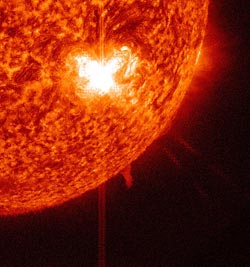Another M-class Flare from Sunspot 1515

The Solar Dynamics Observatory (SDO) captured this image of the sun during an M6.1 flare that peaked at 7:44 AM EDT on July 5, 2012. The image is shown in the 304 Angstrom wavelength, which is typically colorized in red. Credit: NASA/SDO/AIA <br>
Radio blackouts occur when the X-rays or extreme UV light from a flare disturb the layer of Earth's atmosphere known as the ionosphere, through which radio waves travel. The constant changes in the ionosphere change the paths of the radio waves as they move, thus degrading the information they carry.
This affects both high and low frequency radio waves alike. Radio blackouts are rated on a scale from R1 (minor) to R5 (extreme). An R2 radio blackout can result in limited degradation of both high- and low-frequency radio communication and GPS signals.
The same region has also produced numerous coronal mass ejections or CMEs. They have been observed and modeled by NASA's Space Weather Center (SWC) and are thought to be moving relatively slowly, traveling between 300 and 600 miles per second. Since the active region itself is so southerly in the sun, CMEs from this region are generally unlikely to impact Earth.
The strongest flares are classified as X-class, while M-class flares are the second strongest classification. Classified as an M6.1, this latest flare is a little over half the size of the weakest X-class flares.
For more information on flare classification, visit http://www.nasa.gov/mission_pages/sunearth/news/X-class-flares.html.
What is a solar flare? What is a coronal mass ejection?
For answers to these and other space weather questions, please visit the Spaceweather Frequently Asked Questions page.
Karen C. Fox
NASA Goddard Space Flight Center, Greenbelt, MD
Media Contact
All latest news from the category: Physics and Astronomy
This area deals with the fundamental laws and building blocks of nature and how they interact, the properties and the behavior of matter, and research into space and time and their structures.
innovations-report provides in-depth reports and articles on subjects such as astrophysics, laser technologies, nuclear, quantum, particle and solid-state physics, nanotechnologies, planetary research and findings (Mars, Venus) and developments related to the Hubble Telescope.
Newest articles

Superradiant atoms could push the boundaries of how precisely time can be measured
Superradiant atoms can help us measure time more precisely than ever. In a new study, researchers from the University of Copenhagen present a new method for measuring the time interval,…

Ion thermoelectric conversion devices for near room temperature
The electrode sheet of the thermoelectric device consists of ionic hydrogel, which is sandwiched between the electrodes to form, and the Prussian blue on the electrode undergoes a redox reaction…

Zap Energy achieves 37-million-degree temperatures in a compact device
New publication reports record electron temperatures for a small-scale, sheared-flow-stabilized Z-pinch fusion device. In the nine decades since humans first produced fusion reactions, only a few fusion technologies have demonstrated…





















